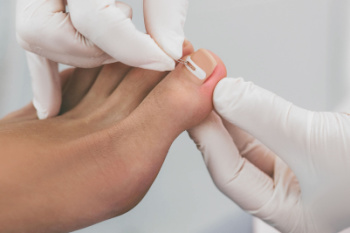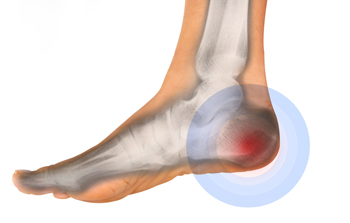Items filtered by date: January 2024
Ingrown Toenails and Infection Control

Ingrown toenails, a common foot ailment, occur when the nail's edge grows into the surrounding skin, leading to discomfort and potential infection. Effective infection control is critical in managing ingrown toenails. To prevent infections, it is important to maintain good foot hygiene. Keep your feet clean and dry, and trim your nails straight across to avoid sharp edges. Additionally, soaking your feet in warm, soapy water can help soften the nail and reduce inflammation. Wearing comfortable, well-fitting shoes that provide adequate toe space will help prevent ingrown toenails. In cases where an infection develops, or for severe or recurring ingrown toenails, it is suggested that you schedule an appointment with a podiatrist who can provide solutions, including possible nail removal.
Ingrown toenails can become painful if they are not treated properly. For more information about ingrown toenails, contact Jack A. Sasiene, DPM of Texas. Our doctor can provide the care you need to keep you pain-free and on your feet.
Ingrown Toenails
Ingrown toenails occur when a toenail grows sideways into the bed of the nail, causing pain, swelling, and possibly infection.
Causes
- Bacterial infections
- Improper nail cutting such as cutting it too short or not straight across
- Trauma to the toe, such as stubbing, which causes the nail to grow back irregularly
- Ill-fitting shoes that bunch the toes too close together
- Genetic predisposition
Prevention
Wearing proper fitting shoes and using proper cutting techniques will also help decrease your risk of developing ingrown toenails.
Treatment
Ingrown toenails are a very treatable foot condition. In minor cases, soaking the affected area in salt or antibacterial soaps will not only help with the ingrown nail itself, but also help prevent any infections from occurring. In more severe cases, surgery is an option. In either case, speaking to your podiatrist about this condition will help you get a better understanding of specific treatment options that are right for you.
If you have any questions, please feel free to contact our office located in Lake Jackson, TX . We offer the newest diagnostic and treatment technologies for all your foot care needs.
Reasons to See a Podiatrist

Podiatrists are specialized healthcare professionals who focus on the diagnosis, treatment, and prevention of foot and ankle disorders. There are various compelling reasons to schedule a visit to a podiatrist. First, persistent foot or ankle pain should not be ignored, as it can be an indicator of an underlying issue. Podiatrists are experts in identifying and addressing the source of your discomfort. They can diagnose conditions such as plantar fasciitis, bunions, or heel spurs, and develop personalized treatment plans. If you are experiencing mobility issues, a podiatrist can help. They can provide custom orthotics or recommend appropriate footwear to improve your gait and balance. Diabetes can take a toll on the feet, leading to complications like neuropathy and ulcers. Regular check-ups with a podiatrist are essential for early detection and preventative care. In short, consulting a podiatrist is beneficial for anyone seeking to maintain their overall foot health, in addition to alleviating foot pain. It is suggested that you visit a podiatrist if you are interested in learning more about the field of podiatry.
If you are experiencing pain in the feet or ankles, don’t join the stubborn majority refusing treatment. Feel free to contact Jack A. Sasiene, DPM from Texas. Our doctor can provide the care you need to keep you pain-free and on your feet.
What Is a Podiatrist?
Someone would seek the care of a podiatrist if they have suffered a foot injury or have common foot ailments such as heal spurs, bunions, arch problems, deformities, ingrown toenails, corns, foot and ankle problems, etc.
Podiatric Treatment
A podiatrist will treat the problematic areas of the feet, ankle or lower leg by prescribing the following:
- Physical therapy
- Drugs
- Orthotic inserts or soles
- Surgery on lower extremity fractures
A common podiatric procedure a podiatrist will use is a scanner or force plate which will allow the podiatrist to know the designs of orthotics. Patients are then told to follow a series of tasks to complete the treatment. The computer will scan the foot a see which areas show weight distribution and pressure points. The podiatrist will read the analysis and then determine which treatment plans are available.
If you have any questions, please feel free to contact our office located in Lake Jackson, TX . We offer the newest diagnostic and treatment technologies for all your foot care needs.
Common Culprits of Heel Pain

Heel pain, a pervasive issue affecting individuals across age groups, can stem from various causes, warranting a closer examination of the contributing factors. Plantar fasciitis, a prevalent cause, results from inflammation of the plantar fascia, which is the band of tissue connecting the heel bone to the toes. This condition is often aggravated by prolonged standing, excessive physical activity, or inadequate footwear. Achilles tendonitis, an inflammation of the Achilles tendon, can also manifest as heel pain, especially among athletes or those engaged in rigorous exercise. Heel spurs, bony protrusions at the base of the heel, may contribute to discomfort, often associated with conditions like plantar fasciitis. Additionally, bursitis or stress fractures in the heel region can give rise to persistent pain. Identifying the specific cause of heel pain is imperative for effective management. Heel pain for any reason can be treated by a podiatrist. If you are experiencing heel pain, it is strongly suggested that you visit this type of doctor who can provide you with effective treatment solutions.
Many people suffer from bouts of heel pain. For more information, contact Jack A. Sasiene, DPM of Texas. Our doctor can provide the care you need to keep you pain-free and on your feet.
Causes of Heel Pain
Heel pain is often associated with plantar fasciitis. The plantar fascia is a band of tissues that extends along the bottom of the foot. A rip or tear in this ligament can cause inflammation of the tissue.
Achilles tendonitis is another cause of heel pain. Inflammation of the Achilles tendon will cause pain from fractures and muscle tearing. Lack of flexibility is also another symptom.
Heel spurs are another cause of pain. When the tissues of the plantar fascia undergo a great deal of stress, it can lead to ligament separation from the heel bone, causing heel spurs.
Why Might Heel Pain Occur?
- Wearing ill-fitting shoes
- Wearing non-supportive shoes
- Weight change
- Excessive running
Treatments
Heel pain should be treated as soon as possible for immediate results. Keeping your feet in a stress-free environment will help. If you suffer from Achilles tendonitis or plantar fasciitis, applying ice will reduce the swelling. Stretching before an exercise like running will help the muscles. Using all these tips will help make heel pain a condition of the past.
If you have any questions, please feel free to contact our office located in Lake Jackson, TX . We offer the newest diagnostic and treatment technologies for all your foot care needs.
Managing Swollen Feet During Pregnancy

Swollen feet during pregnancy is a common concern for expectant mothers. As the body retains more water than usual during pregnancy, swelling in the legs, ankles, and feet, also termed edema, becomes prevalent, particularly at the end of the day and later into the pregnancy. While gradual swelling is generally not harmful, a sudden increase may indicate pre-eclampsia, requiring immediate medical attention. Factors such as hot weather and prolonged standing increase the accumulation of excess water in the lowest parts of the body. Additionally, the pressure from the growing womb can impede blood flow in the legs, leading to fluid buildup and swelling. To alleviate discomfort, it is helpful to avoid prolonged standing, choose comfortable footwear, and elevate your feet whenever possible. Hydration is vital in assisting the body to eliminate excess water. In addition, incorporating gentle exercises, such as foot rotations and bending, can improve blood circulation and help to reduce swelling in the feet and ankles. For help with foot and ankle swelling problems during pregnancy, it is suggested that you schedule an appointment with a podiatrist.
Pregnant women with swollen feet can be treated with a variety of different methods that are readily available. For more information about other cures for swollen feet during pregnancy, consult with Jack A. Sasiene, DPM from Texas. Our doctor will attend to all of your foot and ankle needs.
What Foot Problems Can Arise During Pregnancy?
One problem that can occur is overpronation, which occurs when the arch of the foot flattens and tends to roll inward. This can cause pain and discomfort in your heels while you’re walking or even just standing up, trying to support your baby.
Another problem is edema, or swelling in the extremities. This often affects the feet during pregnancy but tends to occur in the later stages.
How Can I Keep My Feet Healthy During Pregnancy?
- Wearing orthotics can provide extra support for the feet and help distribute weight evenly
- Minimize the amount of time spent walking barefoot
- Wear shoes with good arch support
- Wear shoes that allow for good circulation to the feet
- Elevate feet if you experience swelling
- Massage your feet
- Get regular, light exercise, such as walking, to promote blood circulation to the feet
If you have any questions, please feel free to contact our office located in Lake Jackson, TX . We offer the newest diagnostic and treatment technologies for all your foot care needs.
Exploring the Link Between Foot Pain and Obesity

Obesity, a growing concern in today's society, extends its impact beyond just weight-related health issues, as it may significantly influence the well-being of the feet. The association between foot pain and obesity is a palpable reality, as excess body weight places increased stress on the feet and their intricate structures. Feet, designed to bear the body's load, can become strained and overworked, possibly leading to conditions such as plantar fasciitis and osteoarthritis. The additional pressure on the arches and joints contributes to chronic discomfort, hindering mobility and may diminish the overall quality of life. As body mass increases, so does the likelihood of developing foot pain. Understanding this link underscores the importance of weight management in alleviating and preventing foot-related issues. If you have foot pain, and feel it may be a result of being overweight, it is suggested that you schedule an appointment with a podiatrist who can guide you toward effective relief methods.
Obesity has become very problematic at this point in time and can have extremely negative effects on the feet. If you’re an obese individual and are concerned about your feet, contact Jack A. Sasiene, DPM from Texas. Our doctor can provide the care you need to keep you pain-free and on your feet.
Obesity and Your Feet
Since your feet are what support your entire weight when standing, any additional weight can result in pain and swelling. Being overweight is one of the main contributors to foot complications.
Problems & Complications
Extra Weight – Even putting on just a few extra pounds could create serious complications for your feet. As your weight increases, your balance and body will shift, creating new stresses on your feet. This uneven weight distribution can cause pain, even while doing the simplest tasks, such as walking.
Diabetes – People who are overweight are at serious risk of developing type-2 diabetes, which has a drastic impact on the health of your feet. As you get older, your diabetes might worsen, which could lead to loss of feeling in your feet, sores, and bruises. You could also become more prone to various infections.
Plantar fasciitis – Pressure and stress that is placed on muscles, joints, and tendons can trigger plantar fasciitis, which is an inflammation of tissue that forms along the bottom of the foot.
If you have any questions, please feel free to contact our office located in Lake Jackson, TX . We offer the newest diagnostic and treatment technologies for all your foot care needs.

